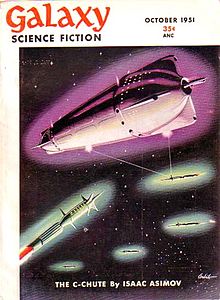Plot summary
During Earth's first interstellar war, a civilian transport traveling to Earth is captured by the Kloros, a chlorine-breathing race of intelligent beings. The ship is commandeered by two Kloros, along with six human civilians as prisoners of war. The humans cannot agree on what they should do, some even coming to blows. Opinions range from a violent counteroffensive to passive acceptance of their situation. Stuart, who has previously spent time as a guest of the Kloros, where he was provided with prosthetic hands when his own were damaged in an accident, posits that the Kloros are masters of chemistry (thus easily able to maintain an atmosphere and provide food for the captives) but less proficient at engineering, hence prefer to steal human ships to use in the war.
Only Mullen, a shy, mild-mannered, short bookkeeper, is willing to make an attempt to take back control of the ship, which he does by exiting via the C-Chute (short for "casualty chute", normally used for launching corpses for burial in space) and entering the control room via the navigational steam-tubes. He kills the two Kloros by spraying them with oxygen.
An unlikely hero, Mullen admits that he was not motivated by bravery, anger, or fear, but rather homesickness for Earth (specifically his hometown, Richmond, Virginia), which he has not seen for 17 years, and that he could not face the prospect of waiting out the war in captivity when on the cusp of returning home.
Notes
Asimov wrote "C-Chute" at the start of what he in 1973 called his "'mature' period", when he "was full of self-confidence" from having earned his PhD, working as a professor at Boston University School of Medicine", publishing three books, and being no longer dependent on Astounding Science Fiction for his fiction. [2]
"C-Chute" was adapted for radio in the anthology series X Minus One , first broadcast on February 8, 1956. [3]
This page is based on this
Wikipedia article Text is available under the
CC BY-SA 4.0 license; additional terms may apply.
Images, videos and audio are available under their respective licenses.
